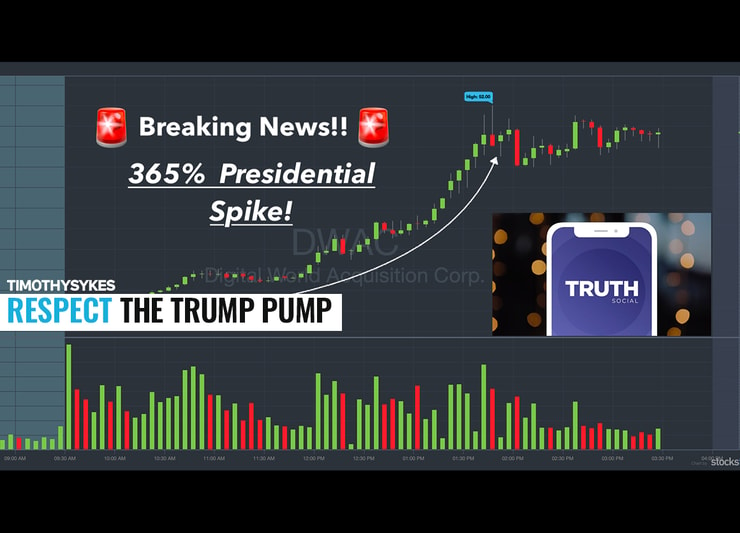Respect the Trump Pump: Key Takeaways
- StocksToTrade’s Breaking News Chat alerted the Trump SPAC news premarket this morning*…
- Retail traders pile into Trump SPAC, sending it soaring over 350%…
- HEED THIS LESSON ABOUT THE DANGERS OF SHORTING…
Here’s how top traders find the hottest news that can supercharge stock spikes
Look at “failed businessman” Donald Trump’s SPAC today…

Digital World Acquisition Corp. (NASDAQ: DWAC) had a massive short squeeze as Trump haters and short sellers tried to beat down the stock.
But retail traders piled in and squeezed the naysayers…
With $DWAC at $50+ you have to feel for the early shorts, I'm glad I stayed in retirement…you have to feel especially for all the #Trump haters who not only thought they won with #Biden but now are getting crushed in the markets betting against Trump…RESPECT THE TRUMP PUMP! pic.twitter.com/qWHbuvlBLn
— Timothy Sykes (@timothysykes) October 21, 2021
Table of Contents
StocksToTrade Breaking News Alerts the Trump Pump
My favorite tool for spotting news nailed another huge alert. STT’s Breaking News Chat team alerted the SPAC news and premarket spike about an hour before the market open.
Some CRAZY action today! $DWAC, on news of an acquisition of former president Donald Trump's new social media platform, high a high of $26.8 so far today.
> Catalyst ✅
> Float Rotation ✅
> Cheap Borrows ✅Did you nail any of this move? pic.twitter.com/Yh7zL7AuO9
— StocksToTrade (@StocksToTrade) October 21, 2021
Never Underestimate a Pump’s Potential
Everyone thought DWAC was junk. So many people are saying that Trump’s a failed businessman with a ton of haters.
Value investors and big hedge funds probably thought shorting this was a sure thing…
Sound familiar?
That’s what they all thought about GameStop Corp. (NYSE: GME). Now, it’s still trading near $200 per share.
NEVER underestimate the power of hype, backed by retail traders, and a celebrity name.
Why Short Selling Is Dangerous
DWAC’s a perfect example of the dangers of short selling. Or being too biased and stubborn in a position.
Shorting’s such an overcrowded niche right now. Then they all get stuck and have to buy to cover to get out. Add in retail day traders chasing the action and you get a perfect storm.
It almost tempts me to get back in the short-selling game…
Look at this absolutely beautifullllllll $DWAC short squeeze, it's definitely tempting me to get back in the game, but no need for extra stress and it's just so much fun to watch on the sidelines, nice pre-theater entertainment before #DuneMovie congrats to all longs, whewwwwww! pic.twitter.com/kHJqNrOSfV
— Timothy Sykes (@timothysykes) October 21, 2021
But I won’t. It’s way too risky. Trading the big mover isn’t the only way to play these massive movers…
Look For Sympathy Plays
There’s no way I was touching DWAC when it was up over 350%. So I did the next best thing and looked for sympathy plays.
I took a speculative trade in another media stock, Salem Media Group, Inc. (NASDAQ: SALM). When DWAC was trading near its highs, I took 5,000 shares of SALM at $4.08. I sold at $4.20 when I didn’t get the big bounce I was hoping for. And I made $585 in profits.**
There’s always a way to trade safely.
That’s what I teach students in my Trading Challenge. Apply for the Challenge today!
What do you think about the Trump pump and DWAC’s insane run? Leave a comment and tell me if you prefer to trade safe like me or if you got in on this crazy squeeze!
Disclaimer
Tim Sykes has a minority ownership stake in StocksToTrade.com.
Never attempt to copy or mirror the trades discussed on this website or in StocksToTrade’s Breaking News Chat alerts. Attempting to do so may result in substantial financial losses. StocksToTrade’s Breaking News Chat alerts are not provided in real-time. For that reason, it is highly unlikely you will be able to buy the stocks at the same entry price, or sell the stocks at the same exit price, to achieve the same or similar profits obtained by the instructors.
Results are not typical and will vary from person to person. Making money trading stocks takes time, dedication, and hard work. Most who receive free or paid content will make little or no money because they will not apply the skills being taught. Any results displayed are exceptional. We do not guarantee any outcome regarding your earnings or income as the factors that impact such results are numerous and uncontrollable.



Leave a reply